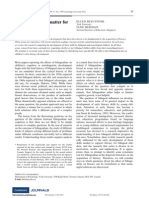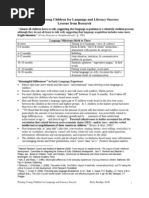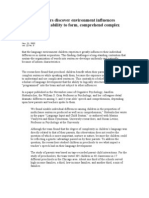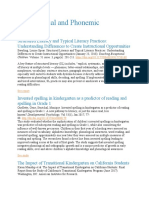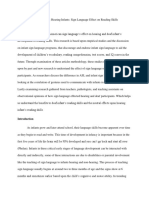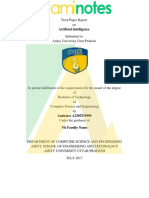In This Issue: Child Development, July/August 2014, Volume 85, Number 4, Pages 1323 - 1329
In This Issue: Child Development, July/August 2014, Volume 85, Number 4, Pages 1323 - 1329
Uploaded by
hirsi200518Copyright:
Available Formats
In This Issue: Child Development, July/August 2014, Volume 85, Number 4, Pages 1323 - 1329
In This Issue: Child Development, July/August 2014, Volume 85, Number 4, Pages 1323 - 1329
Uploaded by
hirsi200518Original Description:
Original Title
Copyright
Available Formats
Share this document
Did you find this document useful?
Is this content inappropriate?
Copyright:
Available Formats
In This Issue: Child Development, July/August 2014, Volume 85, Number 4, Pages 1323 - 1329
In This Issue: Child Development, July/August 2014, Volume 85, Number 4, Pages 1323 - 1329
Uploaded by
hirsi200518Copyright:
Available Formats
In This Issue
Language Development
Before they begin talking, infants have already
begun learning about the language or languages
surrounding them. For example, by 4 months, most
infants have learned their own name, and prefer lis-
tening to a passage containing it than a passage
that doesnt mention it. And research suggests that
individual infants performance in such speechper-
ception tasks may predict their language in the sec-
ond year and beyond. Cristia, Seidl, Junge,
Soderstrom, and Hagoort (p. 1330) evaluated the
strengths and weaknesses of this notion by review-
ing studies to nd that infants perception of speech
predicted the size of their vocabularies signicantly,
with correlations of similar strength to those found
for other traditional infant predictors. The results
have implications for parents and teachers, as well
as for efforts to identify delays and intervene in the
case of problems such as speechlanguage delays,
disorders, and impairments.
Core language skills are stable from early child-
hood to adolescence, with stability stronger from 4 to
10 to 14 years than from 20 months to 4 years,
according to Bornstein, Hahn, Putnick, and Suwal-
sky (p. 1346). Their longitudinal study evaluated sta-
bility of language in about 325 children from early
childhood to adolescence. Stability measures consis-
tency in individual differences over time, so that chil-
dren who show a high level of language at one point
compared to their peers continue to show high levels
later, while other children show low levels across
time. In this study, stability didnt differ between
girls and boys. By assessing multiple domains of lan-
guage using age-appropriate measures and many
sources to evaluate how different measures go
together at each of several ages across childhood, the
study can inform early intervention programs at ages
when theyre likely to be most effective.
The way words sound, or their covers, and the
contexts in which they occur in sentences, or the
company they keep, provide probable cues to their
semantic properties, or what they mean: Nouns
tend to end in y and occur after a and the
(Look, its a kitty!), especially in speech to babies.
Tracking these kinds of cues is referred to as statis-
tical learning and may be central to infants lan-
guage development. For example, many laboratory
studies suggest that infants can learn highly reliable
statistical patterns. These patterns are much more
imperfect in natural languages, raising questions
about whether infants statistical learning abilities
are truly relevant to their language development.
However, Lany (p. 1727), in her study of 40 primar-
ily White, middle- to upper-middle-class 22-month-
olds, nds that infants can learn probable statistical
regularities, and that this ability is connected to
their ability to learn language in the real world.
Do visual and/or auditory problems contribute
to developmental dyslexia (a specic reading dis-
ability)? Steinbrink, Zimmer, Lachmann, Dirichs,
and Kammer (p. 1711) studied about 240 German
elementary school children over the course of rst
and second grade to nd out. Childrens ability to
rapidly process visual information wasnt associ-
ated with reading and spelling performance, but
their ability to do rapid auditory processing did
predict how well they did on reading and spelling
at the end of the year. Because auditory processing
abilities assessed shortly after they started school
were related to their reading and spelling abilities
later on, the study concludes that rapid auditory
processing contributes to later literacy development.
It also suggests that performance on rapid auditory
processing tasks might provide for early identica-
tion or diagnosis of children at risk for dyslexia.
Ethnic-Minority Teen Moms
Teen moms are more likely to suffer lower self-
esteem and have more symptoms of depression
than adult moms. An important part of positive
development for ethnic-minority teens involves
their feelings about their ethnicity: Latino teens
who afrm their ethnic identity tend to feel better
about themselves. Derlan et al. (p. 1357) examined
factors that affect youths positive feelings toward
ethnicity over time among more than 200 Mexican-
origin teen mothers, focusing on whether teens
perceptions of experiencing discrimination and their
connection to the mainstream U.S. culture affected
their feelings about their ethnic group a year later.
2014 The Author
Child Development 2014 Society for Research in Child Development, Inc.
All rights reserved. 0009-3920/2014/8504-0001
DOI: 10.1111/cdev.12276
Child Development, July/August 2014, Volume 85, Number 4, Pages 13231329
Findings: Teen moms who said they were very con-
nected to mainstream U.S. culture had fewer posi-
tive feelings toward their ethnic group when they
perceived experiencing discrimination for being
Mexican. Teens positive feelings toward their eth-
nicity werent harmed by their perceptions of dis-
crimination if they said they didnt feel strongly
connected to mainstream U.S. culture. The ndings
suggest that perceived ethnic discrimination poses a
signicant risk for Mexican-origin adolescent moms
who are very involved in Anglo cultures; as such,
they have important implications for interventions.
Gender Bias
Elementary school children know who their own
friends are and they think they know who other chil-
drens friends are. But they overestimate the impor-
tance of gender in decisions about who is friends
with whom, especially among older children, nd
Neal, Neal, and Cappella (p. 1366). A pair of children
is nine times more likely to be friends if they share the
same gender, but a child is more than 50 times more
likely to believe two classmates are friends when they
are the same gender. The degree to which childrens
inferences about friendships overestimate the impor-
tance of gender is even stronger for older children.
Thus, while gender matters a lot in howchildren form
friendships, children think it is almost the only rele-
vant factor. This study looked at classroom relation-
ships among about 425 low-income, African
American second through fourth graders.
Cue Attraction
Children as young as 3 typically think more posi-
tively about peers who are attractive, the same gen-
der as they are, or of the predominant race. Rennels
and Langlois (p. 1401) nd that for many children,
especially in middle childhood, attractiveness is as
strong a cue, if not a stronger one, than gender or
race in terms of qualities that children use to discrim-
inate others. Their study investigated social biases
across domains in about 100 children aged 311 from
a variety of racial backgrounds. The ndings can
inform interventions and antidiscrimination policies.
Getting a Head Start
One year of Head Start can make a big difference
for children from homes where parents provide less
early academic stimulation, such as reading to chil-
dren, helping them recognize and pronounce letters
and words, and helping them count, according to
Miller, Farkas, Vandell, and Duncan (p. 1385).
Their study also nds that showing parents how
they can assist their children with reading and
counting may help, too. The research team ana-
lyzed data from the Head Start Impact Study, a
nationally representative sample of nearly 5,000
newly entering, eligible 3- and 4-year-olds. The
results suggest that its particularly important that
Head Start be offered to those children whose par-
ents dont report providing high levels of pre-
academic stimulation.
Science and Gender
Gender differences persist in some areas of science
performance and in youths choice of science-
related careers. Studies suggest that spatial skills
the ability to generate and manipulate mental
representations of objectsmay play a role. Gan-
ley, Vasilyeva, and Dulaney (p. 1419) carried out
two studies: In one, researchers gave more than 110
primarily White, middle-class eighth graders a spa-
tial skills test to measure their ability to mentally
rotate, then looked at the students scores on the
science part of a standardized test. They then ana-
lyzed the relation between gender and performance.
In the other study, they examined the performance
of more than 73,240 eighth graders on a state sci-
ence test to determine (based on the ndings of the
rst study) whether questions involving spatial
skills were more likely to show gender differences.
Across both studies, they nd that gender differ-
ences in students spatial skills can help explain
gender differences in students scores on science
tests. This is important because spatial skills can be
improved through training; in particular, such skills
can be taught at young ages using simple materials
such as building with blocks and doing puzzles.
Parents Contributions to Childrens
Cognitive Skills
Working memorythe ability to hold information
in your mind, think about it, and use it to guide
behaviordevelops through adolescence and is key
for successful performance at school and work.
Children from low-income families have been
found to perform worse on tests of working mem-
ory than their peers from better-off families.
1324 In This Issue
Hackman et al. (p. 1433) nd that differences in
working memory that exist at age 10 persist
through the end of adolescence. They also nd that
parents educationone common measure of socio-
economic status (SES)is related to childrens per-
formance on tasks of working memory, and that
neighborhood characteristicsanother common
measure of SESare not. The study looked at more
than 300 children aged 1013 over 4 years. Under-
standing how disparities in working memory
develop has implications for education, and this
study highlights the value of programs that pro-
mote developing working memory early as a way
to prevent disparities in achievement.
An important human characteristic is the ability
to plan rather than respond to an immediate situa-
tion without deliberation. In their longitudinal
study, Friedman et al. (p. 1446) took a broad, inte-
grative look at the development of planning in mid-
dle childhood, studying more than 1,300 children
and their families who were part of the NICHD
Study of Early Child Care and Youth Development.
The children, from preschool through fth grade,
represented a range of racial, ethnic, and socioeco-
nomic backgrounds. The study nds that mothers
education (measured when the children were 1
month old), through its effect on parenting quality
when children were 4, predicted how children did
on tests of memory, attention, and inhibition. This
performance, in turn, predicted childrens planning
skills in rst grade, which predicted their achieve-
ment in reading and math in third grade. It also
nds this path when the same parenting, cognitive,
and academic constructs were measured at later
time points.
Math Skills
Does childrens understanding of fractions build on
earlier forms of mathematical learning, or does the
conceptual leap from whole numbers to fractions
rely predominantly on nonmathematical cognitive
competencies? In their longitudinal study of more
than 160 mostly low-income children from rst
through fourth grades and a variety of racial and
ethnic backgrounds, Vukovic et al. (p. 1461) sought
to unravel the developmental course of fraction
learning. They nd that nonmathematical compe-
tencies were associated with learning whole-num-
ber arithmetic and number line skills, but not
fractions. Also, fraction knowledge has roots in ear-
lier forms of math learning and in early number
knowledge. Together, the ndings indicate that
learning fractions is an extension of earlier math
learning, with nonmath competencies playing a
supportive role. The results suggest children learn
fractions via the same pathway as whole-number
development, a proportional reasoning learning tra-
jectory, or a yet unspecied developmental course
beginning from their early knowledge of numbers.
But they also suggest that learning fractions
requires a particularly tailored type of instruction.
Shortly after learning to count, children learn to
estimatethey attach words like twenty and a thou-
sand to numerical quantities, and do so even with-
out counting all the things being labeled (such as
when they guess how many people are at a party).
We know that children get better at estimating as
they get older, and that being a good estimator is
related to academic successbut we dont know
why. In their study of 60 primarily White, upper-
middle-class 5- to 7-year-olds, Sullivan and Barner
(p. 1740) sought to determine which learning mecha-
nisms children use to attach number words to the
numerical quantities these words represent. Counter
to some prevailing theories of estimation, they nd
that childrens estimation skill wasnt based on their
experience with specic wordmagnitude pairings
(such as hearing the word twelve refer to 12 bagels,
12 students, and 12 pencils). Instead, children used
the structure of the count list (e.g., that 12 is half as
large as 24 and twice as big as 6) to guide their use
of number language to represent numerical quan-
tity. The ndings provide new information about
how children attach language to perception, an
important topic for psychologists, educators, and
policymakers.
Thanks for the Memories
Infants are limited in how many hidden objects
they can remember at a time, but like adults, they
can overcome this limit by chunking items into
sets (much like adults chunk phone numbers into
groups of digits, rather than remembering a single
string of 10 digits). Stahl and Feigenson (p. 1477)
nd that infants can use their knowledge of the
social world to help them chunk objectsfor exam-
ple, a pair of dolls positioned to face each other that
interact with one anotherusing social cues to
expand memory beyond its usual limits. They stud-
ied about 50 primarily White, middle-class 15- to
17-month-olds.
People remember objects when they appear in
the same context in which they were originally
encounteredwhen you see someone from work at
In This Issue 1325
the grocery store, it may take a minute to recognize
her (a memory error). Do both infants and adults
show context effects, given that brain structures
supporting these effects develop into adolescence?
Edgin, Span o, Kawa, and Nadel (p. 1491) exam-
ined the development of these effects in children
from age 3 into adulthood, and in individuals with
Down syndrome (a total of about 110 individuals).
They nd evidence for context effects even in very
young children (3-year-olds) and in children with
Down syndrome, which suggests that context
effects exist at early ages and in individuals with
memory impairment. In typically developing chil-
dren, these effects seem to disappear after age 4,
then reappear later in life, when they are 10
16 years old. The ndings tell us that development
matters when assessing these complex memory
effects, and they suggest that context effects might
be mediated by different brain systems over the life
span.
From Where I Stand
Everyone believes that infants learn a lot from what
they see, but little is known about what infants see
and how visual input changes over development.
Kretch, Franchak, and Adolph (p. 1503) used head-
mounted eye trackers and motion-tracking sensors
to investigate the visual input of forty 13-month-old
crawlers and walkers. They nd that infants view
of the world changes with the developmental tran-
sition from crawling on all fours to walking
upright. While crawling, infants see mostly the oor
in front of their hands. But when they stand up,
their increased height and greater range of head
motion allow them to see more of the wider envi-
ronment, including their caregivers faces and
objects in the distance. By revealing that infants
visual experiences are intimately tied to their pos-
ture, the study deepens our understanding of learn-
ing and development in infancy.
Theory of Mind
Everyday mind reading or theory-of-mind ability
typically benchmarked through false-belief tasks
helps us appreciate that peoples interpretations of
reality are formed and constrained by particular
experiences of the world. Low, Drummond,
Walmsley, and Wang (p. 1519) nd that measures
of childrens and adults eye gaze appeared to tap
an implicit understanding of false beliefs in simple
contexts (beliefs about where an object is located)
but not more complex contexts (beliefs about how
an object or situation might be regarded). In con-
trast, as measured by more explicit verbal methods,
with age, children and adults were able to exibly
predict other peoples belief-based actions across
different contexts. The study, of almost a hundred
3- to 4-year-olds and more than 30 adults, most of
European descent, suggests that early in develop-
ment, an implicit, automatic system is in place that
efciently tracks the mental states of others in
limited contexts, but only later is a more exible
system in place for more generally making sense of
the complex and varied business of other peoples
minds.
Around ages 4 to 5, children realize that unob-
servable mental states, such as thoughts, beliefs,
and emotions, underlie much of human behavior,
an achievement referred to as theory of mind. Part
of theory of mind is understanding that minds rep-
resent reality, such that actions are based on what
we think is true, rather than whats actually true. In
their longitudinal study, Lillard and Kavanaugh (p.
1535) examined the extent to which various sym-
bolic skills that emerge in the years just prior to
ages 4 and 5pretend play, language, and under-
standing representationsmight undergird theory
of mind. About 60 children, most of them White,
were tested from ages 2 and a half to 4 years on
symbolic precursor skills, and were given theory of
mind tests at ages 4 and 5. A subset of the symbolic
variables was signicantly related to theory of mind
at ages 4 and 5, providing the best evidence to date
that theory of mind is undergirded by a symbolic
element that also supports language, pretend play,
and representational understanding.
Literacy and Language Immersion
Parents of children in early elementary school are
encouraged to help them acquire literacy skills at
home, but parents whose children are in language
immersion programs are faced with a dilemma
should they provide home literacy activities in the
language learned at school even though they may
have minimal knowledge of that language, or
should they provide home literacy activities in Eng-
lish? In their longitudinal work (children were
followed from kindergarten to second grade),
Senechal and LeFevre (p. 1552) tested whether 100
English-speaking Canadian children learning to
read in French would show links between home
literacy experiences and later English reading skills
1326 In This Issue
when parents provided home literacy activities in
English. Findings: Parents home literacy activities
in the home language (English) were related to chil-
drens reading development (in English) even
though their schooling was primarily in French.
This suggests that parents can provide literacy
activities in their rst language at home that might
help how children learn to read in that language
even when a different language is used in school.
The Roots of Shyness
Previous studies have found that children who are
inhibited in their behaviorthose who are shy,
fearful, and withdraw from new situationstend to
have lower language abilities, but its unclear why.
Smith Watts et al. (p. 1569) examined this associa-
tion in more than 800 primarily White toddlers
(ages 14, 20, and 24 months). They nd that chil-
dren who are behaviorally inhibited tended to
speak less but their ability to understand whats
being said was not signicantly different from less
shy peers. In other words, these children had per-
formance problems when speaking with others, but
they didnt lack capability, suggesting that theyre
merely reluctant to respond rather than delayed or
decient in understanding language. They also nd
that girls were shyer and had better language abil-
ity than boys, but the degree to which shyness was
related to language development was similar for
both genders. These results indicate that inhibited
behaviors like shyness dont hamper language
acquisition, but that behaviorally inhibited children
may need support as they develop their speaking
abilities.
Another study on shyness looked at socially
wary children. These children are shy, and their
discomfort with social situations causes them to
withdraw from others and isolate themselves. Being
socially wary is thought to boost childrens risk of
developing emotional, social, and academic prob-
lems. In their longitudinal study of about 100 pri-
marily White, middle-class 2- to 4-year-olds,
Hastings, Kahle, and Nuselovici (p. 1586) nd that
socially wary preschoolers adjusted well in school,
developing good social skills and doing well aca-
demically 5 years later if they were better able to
regulate their physiological responsiveness as pre-
schoolers and had moms who werent overprotec-
tive. But preschoolers who had poor regulatory
capacity or overprotective moms (or both) had
more emotional problems and more social difcul-
ties, and did worse academically. The study can
inform intervention programs to help socially wary
children thrive.
Beliefs and Religion
How do children come to understand knowledge in
people and God? Kiessling and Perner (p. 1601)
looked at about a hundred 3- to 6-year-olds attend-
ing Catholic kindergartens in Austria, focusing on
their understanding of knowledge in different peo-
ple (mother, baby) and God. Younger children
tended to project their own knowledge or ignorance
on people as well as on God, while older children
either anthropomorphized God or, in still older
children, conceived him as knowledgeable. The
ndings challenge the developmental account that
young children are born believers. On the con-
trary, children start thinking that Gods knowledge
is as limited as peoples knowledge and only later
deem God to be omniscient. The study helps us
understand more about childrens belief systems
and how they develop.
Children and adults tend to believe that people
have certain features that are immortal and that
they transcend death and persist forever in some
mental form. Emmons and Kelemen (p. 1617)
explored where that belief originates by examining
almost 300 Ecuadorian 5- to 12-year-olds beliefs
about their mental and bodily capacities prior to
conception, that is, before life. Both urban and rural
indigenous children tended to treat their emotions
and desires as having always existed, even before
they were conceived and independent of their phys-
ical existence. The ndings suggest that from early
in development, children nd it hard to suppress
the idea that people exist in some mental form, and
that beliefs about personal immortality come from
an unlearned and potentially universal psychologi-
cal tendency.
Religious adolescents tend to have fewer prob-
lem behaviors (smoking, stealing, truancy) and to
develop friendships with other peers who are reli-
gious. French, Christ, Lu, and Purwono (p. 1634)
sought to determine how changes in teens religios-
ity over adolescence affected their behavior or their
friendships. Based on their longitudinal study of
about 560 Indonesian Muslim 15-year-olds (a group
thats religiously homogeneous and very religious),
they nd that changes over time in teens religiosity
closely mapped changes in their friends religiosity.
Over the 2-year study, teens religiosity changed
rst and their friends religiosity changed during
the subsequent year, suggesting that adolescents
In This Issue 1327
chose new friends who were similar to them.
Changes in religiosity also were associated with
changes in problem behavior: Teens who increased
in religiosity decreased their engagement in prob-
lem behavior, while teens who decreased in religi-
osity took part in more problem behavior. The
study points to the value of considering teens reli-
giosity as part of their social development.
Focus on Peers
Children perceived as popular by their classmates
arent necessarily well liked or accepted. These chil-
dren are also often arrogant, disobedient, aggres-
sive, and socially dominant. How do teachers
inuence perceived popularity and peer accep-
tance? De Laet et al. (p. 1647), in their study of
almost 600 Belgian fourth through sixth graders,
nd that teachers may increase certain students
perceived popularity by relational conict: Children
who conicted more with their teacher were seen
as more popular by classmates the next year, sug-
gesting that teachers unintentionally boost certain
childrens social standing through conict. Also,
children who were accepted by their peers seemed
to get more support from their teachers the follow-
ing year, which further increased how much their
peers accepted them. The ndings can help teachers
understand their role as social architect and can
inform interventions to promote positive relation-
ships in classrooms.
Effective communication and interpersonal inter-
actionsincluding relationships with peers of the
other genderare a key to successful personal, aca-
demic, and professional success. Yet starting in
early childhood, on average, girls and boys spend
more time with peers of their own gender, a phe-
nomenon termed gender segregation. As a conse-
quence of this time apart, males and females learn
different ways of communicating and relating to
their peers. Zosuls, Field, Martin, Andrews, and
England (p. 1663) studied about 200 fourth graders
and more than 850 seventh and eighth graders from
middle-class families and ethnically diverse back-
grounds. They nd that childrens condence in
their ability to understand and relate to other-gen-
der peers is important to forming positive, mean-
ingful relationships between girls and boys, and
breaking the gender divide.
Adolescence is a time when youth become
increasingly involved in the world beyond the fam-
ily. Yet, whether time spent with peers is a benet
for adolescents well-being remains a question. In
their study of children in about 200 White, middle-
class families that spanned 8 years (children were
811 at the start), Lam, McHale, and Crouter (p.
1677) examined the developmental patterns and
adjustment implications of time with peers during
adolescence. Findings: Time with same-sex peers
peaked in midadolescence, but time with mixed/
opposite-sex peers, when at least one opposite-sex
peer was present, increased from early to late ado-
lescence. Time with mixed/opposite-sex peers with-
out an adult present predicted problem behaviors
and symptoms of depression a year later. Time
with mixed/opposite-sex peer groups in the pres-
ence of an adult, however, was linked to better
grades in the next year. The results underscore the
importance of adults in supervising (but not direct-
ing) youth activities.
Community Violence
Exposure to community violence is an important
risk factor for exhibiting aggression during adoles-
cence, but its only one of many factors that may
affect adolescents adjustment. In their study of
almost 1,200 high-risk sixth graders, Farrell, Mehari,
Kramer, and Goncy (p. 1694) examined the inu-
ence of concentrated disadvantagea cluster of
neighborhood factors such as poverty rate, percent-
age receiving public assistance, education level, and
resident instabilityto nd that its related to more
instances of witnessing violence and victimization,
and more engagement in physically aggressive
behavior among teens. However, more exposure to
violence didnt account for why teens in very disad-
vantaged neighborhoods were more aggressive.
Based on changes during sixth grade, the study
suggests a two-way relation between witnessing
violence and aggression: Witnessing violence
predicted increases in aggression, and frequency of
aggression predicted increases in frequency of
witnessing violence. By identifying neighborhood
and individual factors that affect teens lives, the
study can inform comprehensive prevention efforts.
Getting Sorted
Children of a certain age often have difculty exi-
bly shifting attention between different dimensions
of a task. Jowkar-Baniani and Schmuckler (p.
1373) looked at a popular measure of attention
shifting and executive function, the Dimensional
Change Card Sorting task, in which children have
1328 In This Issue
to sort stimuli depicted on cards on the basis of one
dimension (such as color), then shift to sorting the
stimuli on the basis of a different dimension (such
as shape). In particular, they looked at how changes
to irrelevant features of the cards (such as the back-
ground color or shape of the cards themselves)
affected the way 125 preschoolers sorted. Results
generally indicated that even when such irrelevant
features were changed, young childrens sorting
behavior improved, suggesting that such changes
heighten childrens attention to the overall task,
which leads to better performance. The ndings
help us understand how attention to background,
lower-level perceptual information can inuence
young childrens cognitive ability.
Child Maltreatment
Children begin to lie by age 2, and their early lies
tend to be denials of wrongdoing. Surveys of adults
consistently nd that many who were maltreated as
children never disclosed it to anyone when they
were young. Little research has explored how chil-
drens reluctance to disclose wrongdoing can be
overcome. Lyon et al. (p. 1756) found a new way
to elicit honestywhat they call a putative confes-
sion. They worked with more than 260 primarily
low-income children ages 49, half of whom had
been abused or neglected by parents (the children
were from a range of ethnic and racial back-
grounds). A friendly stranger played with each
child with a series of toys, two of which appeared
to break. The stranger expressed concern that he or
she would get in trouble for playing with the
breakable toys and asked the child to keep the
breakage a secret. An interviewer then questioned
the child about what happened, saying that the
stranger had told me everything that happened
and he wants you to tell the truth. This approach
increased childrens honesty without increasing
false reports. With further study, the approach may
prove useful in investigations of child maltreat-
ment.
Anne Bridgman
In This Issue 1329
You might also like
- ECG Interpretation Cheat SheetDocument1 pageECG Interpretation Cheat Sheethirsi20051883% (30)
- Self-Reinforcement and Self EfficacyDocument6 pagesSelf-Reinforcement and Self EfficacyMoureen NdaganoNo ratings yet
- List of MCQS EndocrineDocument40 pagesList of MCQS Endocrinehirsi200518100% (1)
- History of Present IllnessDocument10 pagesHistory of Present Illnesshirsi200518No ratings yet
- Endocrinology HandbookDocument75 pagesEndocrinology Handbookhirsi200518No ratings yet
- Rowe JCL 2008Document22 pagesRowe JCL 2008bolinha com um BNo ratings yet
- Tamis-LeMonda Rodriguez Encyclopedia Early Childhood Education 2014Document7 pagesTamis-LeMonda Rodriguez Encyclopedia Early Childhood Education 2014alphasouvNo ratings yet
- Parents and Preschool Children Interacting With Storybooks: Children's Early Literacy AchievementDocument16 pagesParents and Preschool Children Interacting With Storybooks: Children's Early Literacy AchievementNurul Syazwani AbidinNo ratings yet
- ASDC Sign Language For All-EnglishDocument28 pagesASDC Sign Language For All-EnglishAlifia Rizki100% (1)
- Bilingual in Early Literacy PDFDocument10 pagesBilingual in Early Literacy PDFsavemydaysNo ratings yet
- Pathways To Literacy: Connections Between Family Assets and Preschool Children's Emergent Literacy SkillsDocument18 pagesPathways To Literacy: Connections Between Family Assets and Preschool Children's Emergent Literacy Skillsapi-277160707No ratings yet
- Visions For Literacy: Parents' Aspirations For Reading in Children With Down SyndromeDocument8 pagesVisions For Literacy: Parents' Aspirations For Reading in Children With Down SyndromeValee ValentinaNo ratings yet
- Priming Young Children For Language and Literacy Success: Lessons From ResearchDocument4 pagesPriming Young Children For Language and Literacy Success: Lessons From ResearchAnindita PalNo ratings yet
- Infant-Language, Shyness and SocialContextDocument9 pagesInfant-Language, Shyness and SocialContextJuan Lino Fernandez GonzalezNo ratings yet
- Hablantes Tardíos (Inglés)Document20 pagesHablantes Tardíos (Inglés)Ana BenítezNo ratings yet
- Chanda Literature Review PaperDocument39 pagesChanda Literature Review Paperapi-399444494No ratings yet
- Elsevier_RelativeEfficacyOfParentAndTeacherInvolvementInASharedReadingInterventionForPreschoolChildrenFromLowIncomeBackgrounds_1998Document28 pagesElsevier_RelativeEfficacyOfParentAndTeacherInvolvementInASharedReadingInterventionForPreschoolChildrenFromLowIncomeBackgrounds_1998Dima ToubajiNo ratings yet
- Arp WalkerDocument18 pagesArp Walkerapi-521335305No ratings yet
- Ingilizce Makale Dil GelişimiDocument13 pagesIngilizce Makale Dil GelişimimuberraatekinnNo ratings yet
- Literacy LanguageDocument20 pagesLiteracy LanguageErsya MuslihNo ratings yet
- Late Talkers: A Population-Based Study of Risk Factors and School Readiness ConsequencesDocument20 pagesLate Talkers: A Population-Based Study of Risk Factors and School Readiness ConsequencesEssa BagusNo ratings yet
- The Influence of Family Factors On Children Early Literacy SkillsDocument28 pagesThe Influence of Family Factors On Children Early Literacy SkillsSalman HasibuanNo ratings yet
- Filipino Parents Used Swear Words in Household Affecting Family RelationsDocument8 pagesFilipino Parents Used Swear Words in Household Affecting Family RelationsPsychology and Education: A Multidisciplinary JournalNo ratings yet
- Researchers Discover Environment Influences Children's Ability To Form, Comprehend Complex SentencesDocument3 pagesResearchers Discover Environment Influences Children's Ability To Form, Comprehend Complex SentencesOsman MamatNo ratings yet
- AGIZero To ThreeScienceReviewSept2013 PDFDocument10 pagesAGIZero To ThreeScienceReviewSept2013 PDFMaria AparecidaNo ratings yet
- The Effects of Bilingualism On Theory of Mind DevelopmentDocument16 pagesThe Effects of Bilingualism On Theory of Mind DevelopmentRenata JurevičiūtėNo ratings yet
- Using Story Reading and Explicit Instruction in The Vocabulary Acquisition of Kindergarten ChildrenDocument17 pagesUsing Story Reading and Explicit Instruction in The Vocabulary Acquisition of Kindergarten ChildrenpyriadNo ratings yet
- ELL2-Language DevelopmentDocument16 pagesELL2-Language DevelopmentLaurensia Aptik EvAnJeliNo ratings yet
- Helpful Literacy QuotesDocument149 pagesHelpful Literacy QuotesMaria Angeline Delos SantosNo ratings yet
- Multigenerational Giftedness: Perceptions of Giftedness Across Three GenerationsDocument27 pagesMultigenerational Giftedness: Perceptions of Giftedness Across Three GenerationsBianca AxinteNo ratings yet
- 2011 L Rodríguez-Trajectories of The Home Learning Environment Across 5 Years - Child DevDocument18 pages2011 L Rodríguez-Trajectories of The Home Learning Environment Across 5 Years - Child DevDaniel Castañeda SánchezNo ratings yet
- Parental Involvement in The Development of Children's Reading Skill: A Five-Year Longitudinal StudyDocument16 pagesParental Involvement in The Development of Children's Reading Skill: A Five-Year Longitudinal StudyNurul Syazwani AbidinNo ratings yet
- Schooling Effects HearingDocument24 pagesSchooling Effects HearingIustina SolovanNo ratings yet
- Beginning Reading FinalDocument23 pagesBeginning Reading FinalVon Lloyd Ledesma LorenNo ratings yet
- Children Learn Second Languages Quickly and EasilyDocument15 pagesChildren Learn Second Languages Quickly and EasilyJohn Gerald PilarNo ratings yet
- Language Skills and Nonverbal Cognitive Processes Associated With Reading Comprehension in Deaf ChildrenDocument8 pagesLanguage Skills and Nonverbal Cognitive Processes Associated With Reading Comprehension in Deaf Childrenlope86No ratings yet
- Phonological and Phonemic AwarenessDocument11 pagesPhonological and Phonemic AwarenessMay Anne AlmarioNo ratings yet
- Assessment 1 - Uyen Nguyen - S1441456Document5 pagesAssessment 1 - Uyen Nguyen - S1441456Nguyen UyenNo ratings yet
- Precursorsof DyslexiaDocument26 pagesPrecursorsof DyslexiaiprintslNo ratings yet
- Journal of Child LanguageDocument44 pagesJournal of Child LanguageHeri Zalmes Dodge TomahawkNo ratings yet
- Derasin Final4Document23 pagesDerasin Final4Valdez FeYnNo ratings yet
- The Unique Contribution of Home Literacy Environment To Differences in Early Literacy SkillsDocument12 pagesThe Unique Contribution of Home Literacy Environment To Differences in Early Literacy SkillsmuberraatekinnNo ratings yet
- Language Intervention Research in Early Childhood Care and EducationDocument18 pagesLanguage Intervention Research in Early Childhood Care and EducationRosmery Naupari AlvarezNo ratings yet
- Nihms 429985Document17 pagesNihms 429985Aliana Gonzalez CachoNo ratings yet
- Comm CommResearchProposalDocument9 pagesComm CommResearchProposalWilhemina BrightsNo ratings yet
- Increasing The Expressive Vocabulary of Young Children Learning English As A Second Language Through Parent InvolvementDocument8 pagesIncreasing The Expressive Vocabulary of Young Children Learning English As A Second Language Through Parent InvolvementSamuel AgudeloNo ratings yet
- Readingaloudtochildren Adc July2008Document4 pagesReadingaloudtochildren Adc July2008api-249811172No ratings yet
- Assigment 1 2Document17 pagesAssigment 1 2api-291897845No ratings yet
- Early Communicative Gestures Prospectively Predict Language DevelopmentDocument17 pagesEarly Communicative Gestures Prospectively Predict Language DevelopmentKANIA KUSUMA WARDANINo ratings yet
- Vocal Cues and Children's Mental Representations of Narratives: Effects of Incongruent Cues On Story ComprehensionDocument17 pagesVocal Cues and Children's Mental Representations of Narratives: Effects of Incongruent Cues On Story ComprehensionAdrienn MatheNo ratings yet
- 1 s2.0 S0271530916300945 MainDocument10 pages1 s2.0 S0271530916300945 MainMppaolantonio PaolantonioNo ratings yet
- Dialogic ReadingDocument12 pagesDialogic Readingmagar telvNo ratings yet
- Building A Powerful Reading ProgramDocument17 pagesBuilding A Powerful Reading ProgramInga Budadoy NaudadongNo ratings yet
- Research ProposalDocument16 pagesResearch ProposalSuleman SaeedNo ratings yet
- Critical AnalysisDocument39 pagesCritical Analysisapi-283884559No ratings yet
- Parent-Child Conversations About Letters and PicturesDocument21 pagesParent-Child Conversations About Letters and PicturesAndreea DobritanNo ratings yet
- Social Contexts of Development: Parent-Child Interactions During Reading and PlayDocument23 pagesSocial Contexts of Development: Parent-Child Interactions During Reading and PlaybernardparNo ratings yet
- Acquisition of Literacy in Bilingual ChildrenDocument41 pagesAcquisition of Literacy in Bilingual ChildrenGeoff CavanoughNo ratings yet
- Developing Identity in Diversity: A Second Language Acquisition ExperienceDocument10 pagesDeveloping Identity in Diversity: A Second Language Acquisition ExperienceAanindia Brilyainza DiaNo ratings yet
- McburneyjamiebiblioDocument5 pagesMcburneyjamiebiblioapi-401233610No ratings yet
- Child - Language - Development - Kel 5 (1) - 1Document13 pagesChild - Language - Development - Kel 5 (1) - 1Jihan nafisa20No ratings yet
- Variable de Género: Contexto Socio - HistóricoDocument8 pagesVariable de Género: Contexto Socio - HistóricoJoseph NándezNo ratings yet
- Final CapstoneDocument14 pagesFinal Capstoneapi-434974983No ratings yet
- Article The Early Catastrophe AFT Spring 2003Document18 pagesArticle The Early Catastrophe AFT Spring 2003e.sepulvedaferradaNo ratings yet
- Gale Researcher Guide for: Comprehension and Meaning in LanguageFrom EverandGale Researcher Guide for: Comprehension and Meaning in LanguageNo ratings yet
- The Second Year Neurology Lockbook 2016Document2 pagesThe Second Year Neurology Lockbook 2016hirsi200518No ratings yet
- 1472 6874 10 8 PDFDocument7 pages1472 6874 10 8 PDFhirsi200518No ratings yet
- M-Mode Echocardiography: John N. Hamaty D.O. SJHGDocument37 pagesM-Mode Echocardiography: John N. Hamaty D.O. SJHGhirsi200518No ratings yet
- Objectives: Logical Framework Analysis (LFA)Document10 pagesObjectives: Logical Framework Analysis (LFA)hirsi200518No ratings yet
- Introduction To Echocardiography 2Document26 pagesIntroduction To Echocardiography 2Sandra GutierrezNo ratings yet
- Examination of The Newborn BabyDocument44 pagesExamination of The Newborn Babyhirsi200518No ratings yet
- MDR Somalia EID March 2013Document3 pagesMDR Somalia EID March 2013hirsi200518No ratings yet
- Pediatric Clinical ExamintionDocument74 pagesPediatric Clinical Examintionhirsi200518100% (1)
- General Principles of Gastroentorylogy.Document32 pagesGeneral Principles of Gastroentorylogy.hirsi200518No ratings yet
- Neurology MCQDocument16 pagesNeurology MCQSudhakar Subramanian100% (1)
- HistoryDocument64 pagesHistoryhirsi200518No ratings yet
- Application Form: M.SC Scholarship Programme For Eligible Member CountriesDocument9 pagesApplication Form: M.SC Scholarship Programme For Eligible Member Countrieshirsi200518No ratings yet
- Thorndikes Theory of LearningDocument19 pagesThorndikes Theory of LearningRose Marie Jaromay OderioNo ratings yet
- Aisyah Binti MD Nor NO. MATRIK: U2104435 Pensyarah: Dr. Siaw Yan LiDocument7 pagesAisyah Binti MD Nor NO. MATRIK: U2104435 Pensyarah: Dr. Siaw Yan LiEye SyahNo ratings yet
- UNIT-2-NOTES - Self Management Skills-IXDocument8 pagesUNIT-2-NOTES - Self Management Skills-IXVaishnavi Joshi50% (4)
- Master Your Emotions (Workbook)Document36 pagesMaster Your Emotions (Workbook)No tengoNo ratings yet
- Aminotes - NTCC Project Artificial IntelligenceDocument17 pagesAminotes - NTCC Project Artificial IntelligenceShashwat ShuklaNo ratings yet
- 4 - Week 4 - The Self According To PsychologyDocument4 pages4 - Week 4 - The Self According To PsychologySteve RogersNo ratings yet
- EmotiiDocument2 pagesEmotiiCiprian CiobanuNo ratings yet
- OCR-A-Level Psychology Study-Summaries Core-SampleDocument15 pagesOCR-A-Level Psychology Study-Summaries Core-SampleAyaNo ratings yet
- Psychology Theories of Learning From S.K MangalDocument21 pagesPsychology Theories of Learning From S.K MangalAyushi PandyaNo ratings yet
- Chapter 2 Social IdentityDocument28 pagesChapter 2 Social Identityally natashaNo ratings yet
- (IRISH PARAGGUA) Reflection Paper, Theories of Personality-1Document5 pages(IRISH PARAGGUA) Reflection Paper, Theories of Personality-1irish paragguaNo ratings yet
- Multi CritterialDocument38 pagesMulti CritterialRaquel PanillosNo ratings yet
- Awaken The Giant Within - Summary - Review in PDF - The Power MovesDocument11 pagesAwaken The Giant Within - Summary - Review in PDF - The Power MovesAnte Perković100% (1)
- Sample Paper For COLA100Document6 pagesSample Paper For COLA100Bobby HillNo ratings yet
- Theory of Mind AutismDocument2 pagesTheory of Mind AutismLeticia JuradoNo ratings yet
- My Psychology 1st Edition Pomerantz Test BankDocument45 pagesMy Psychology 1st Edition Pomerantz Test Banksamuelhammondbzksifqnmt100% (30)
- Mapeh Q2 W9Document9 pagesMapeh Q2 W9Mickey Maureen DizonNo ratings yet
- PERSONAL DEVELOPMENT Module 3Document10 pagesPERSONAL DEVELOPMENT Module 3Gil PunowskiNo ratings yet
- UTS Module 4 Semi FinalsDocument24 pagesUTS Module 4 Semi Finalsgilbertjustin469No ratings yet
- Schools of Thought in Second Language AcquisitioNDocument19 pagesSchools of Thought in Second Language AcquisitioNMa. Theresa O. MerceneNo ratings yet
- Philosophical Perspective of The Self 2Document24 pagesPhilosophical Perspective of The Self 2ochoapauline02No ratings yet
- SOULMAKINGDocument18 pagesSOULMAKINGNezukoNo ratings yet
- Yourself Externalized (Neville Goddard)Document1 pageYourself Externalized (Neville Goddard)TC EmergeNo ratings yet
- UHV II Lecture 3 - Happiness and Prosperity v4Document10 pagesUHV II Lecture 3 - Happiness and Prosperity v4shashrzNo ratings yet
- University of Zimbabwe: Learning Principles (Psy 213)Document5 pagesUniversity of Zimbabwe: Learning Principles (Psy 213)Enniah MlalaziNo ratings yet
- Neo Behaviorism FinalDocument30 pagesNeo Behaviorism FinalsalviesanquilosNo ratings yet
- AP Psych History and Approaches Interactive NotebookDocument13 pagesAP Psych History and Approaches Interactive NotebookZaina NasserNo ratings yet
- Module 6Document10 pagesModule 6Antonette ArmaNo ratings yet
- A Review of Radical Behaviorism For ABA PractitionDocument6 pagesA Review of Radical Behaviorism For ABA PractitionJimmy MoralesNo ratings yet









